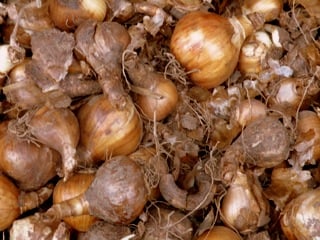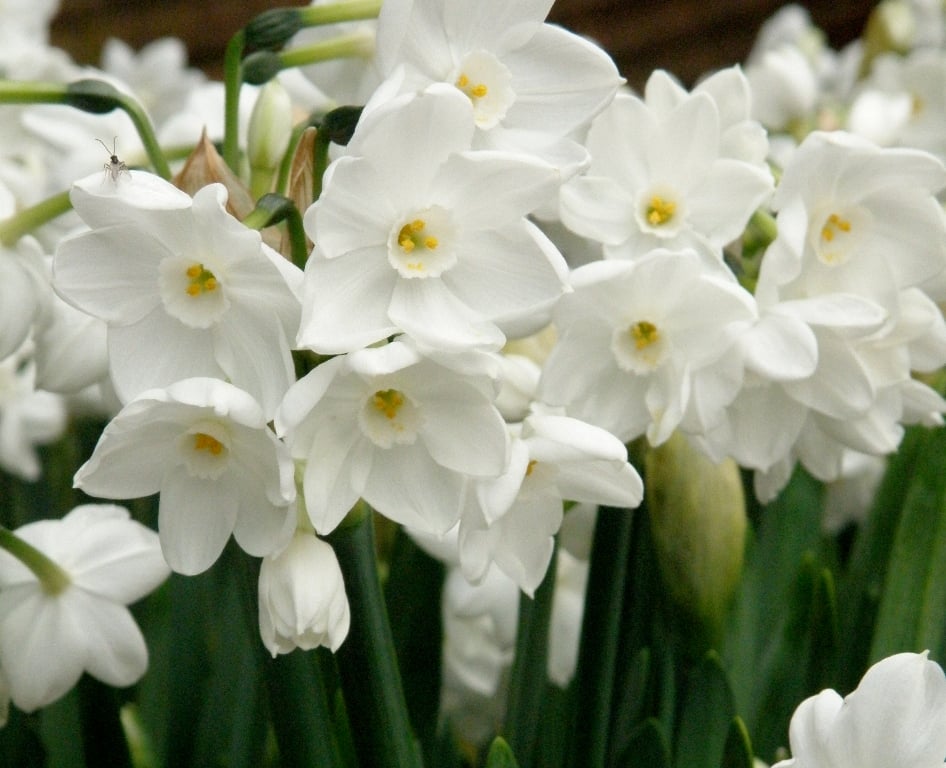

Contributor
- Topics: Archive
Planted in fall, the returning rains initiate growth producing some of the earliest showy blooms of the new growing season.

Extremely drought tolerant for six months of the year, daffodils thrive in Western gardens. Long, arid summers keep dormant bulbs dry, helping to prevent basal rot and other diseases common where soil conditions are warm and moist. With their power to lift our spirits at the end of a drab winter with colorful blooms and fragrance, daffodils convince us that spring has arrived. For spring bloom, bulbs must be planted in the fall. Now is the time to start thinking about next year’s show.
You’ll find the best selection of choice varieties through reputable mail order sources recommended by the American Daffodil Society and through a variety of West Coast specialty bulb growers. Quality daffodil catalogs organize their stock into 13 divisions categorized by shape, size, color, and bloom time, providing lots useful information for selecting just the right bulb for your garden’s situation.
[sidebar]
These tried and true favorites thrive with or without summer water:
- Carlton
- Dutch Master
- Erlicheer
- February Gold
- Gigantic Star
- Golden Dawn
- Ice Follies
- Jules Verne
- Mount Hood
- Rijnveld’s Early Sensation
- Saint Keverne
- Sir Winston Churchill
- Spellbinder
- Unsurpassable [/sidebar]
For planting in a garden situation alongside annuals, perennials, and shrubs, large trumpet types, large-cupped, and intermediate small-cupped daffodils and their doubles that are native to the cool, moist mountains of Europe tolerate summer watering and still perform well. This group, which also combines easily with other spring-blooming bulbs in pots and display beds, declines over time, especially after a series of dry years, making the plants less suitable for naturalizing.
Daffodils selected for growing in containers perform best if they are compact growers, long-blooming, durable in the rain, with large showy flowers like the pale glowing sulfur trumpets of ‘Lemon Glow’, or the pure yellow mid-blooming, large-cupped ‘Camelot’. Especially showy forms and those bulbs bred for the show bench are also best grown in pots where their charms can be appreciated up close.
Get Growing
Daffodils are easy to grow and tough. In addition to full sun and good drainage, plants require a chilling period (35° to 40°F) for eight to ten weeks to initiate flower bud formation; conditions easily satisfied in most regions up and down the West Coast. Low-chill daffodils like jonquils and tazettas are best for warmer regions like Southern California where winter chilling is marginal.

Plant bulbs in full sun and provide well-drained soil. Daffodils resent standing water; heavy clay, which retains moisture longer in dry years, is workable only if water does not pool in the rainy season. Additional amendments and fertilizers are not required and only promote lush growth subject to disease.
Keep plants evenly moist when they are actively growing and blooming and wait until leaves turn yellow and dry before cutting back to the ground—a trial for gardeners impatient to remove the unsightly foliage. Disguise ripening leaves with emerging perennials or bedding plants, or plant bulbs in pots, which can be discreetly whisked away to ripen off-stage after blooming. Where fire is a concern, it is best to select early blooming tazettas which ripen completely before mowing begins. Buried and out of sight, summer-dormant daffodils are protected through long, hot summers by layers of bulb scales.
Long-lived and ready multipliers, daffodils are a good investment. In warmer regions, gardeners can grow very early-, early-, mid-, late-, and very late-blooming cultivars keeping a sequence of daffodils blooming October to May, starting with the fragrant tazetta ‘Autumn Colors Group’ and ending with the glowing pure yellow trumpet ‘Pay Day’.
Rodents and deer leave poisonous daffodil bulbs alone. In a wet year, slugs and snails feasting on the blooms can ruin the display. Control damage in small plantings with organic slug bait or by keeping a few ducks around to gobble up the pests.
Immortalized throughout history by poets and playwrights, daffodils have long been thought of as a staple of dewy English gardens. But these resilient hardy bulbs are beloved by gardeners everywhere. They are perfect plants for California’s Mediterranean climate, with many garden uses, and so many cultivars to choose from.

Design tips
- Plant the ivory trumpet ‘Mount Hood’, glistening white tazetta ‘Inbal’ or the creamy white ‘Erlicheer’ in combination with magnolias, camellias, and rhododendrons that bloom at the same time in harmonious reds, pinks, and purples to avoid clashing with yellow daffodils.
- Combine the stately late jonquil ‘Stratosphere’ which can grow to 36 inches tall with late tulips, Siberian wallflowers (Cherianthus), baby blue eyes (Nemophila menziesii), and broad-leaved forget-me-not (Myosotis latifolia).
- Edge pathways and roadsides with swathes of the miniature pale yellow triandrus ‘Hawera’, an excellent naturalizer, where its charm and fragrance can be appreciated.
Share:
Social Media
Garden Futurist Podcast
Most Popular
Videos
Topics
Related Posts

Low Maintenance Gardens – Better for Pollinators and People
Autumn 2022 “I come out every day. It’s therapy, my meditation.” Janet’s young garden transformed from overgrown, invasive plants to mostly natives. The dailiness of

Calochortophilia: A Californian’s Love Affair with a Genus
Summer 2022 I can chart the progression of my life by Calochortus. For the last two decades, at least. As a teenage girl growing up

Pacific Plant People: Carol Bornstein
Spring 2022 Public gardens play a key role in demonstrating naturalistic planting design, selecting native and adapted plants for habitat, and testing techniques for reducing

Add Year-Round Interest and Winter Blooms for Pollinators
Spring 2022 This article was created from an Interview by Merrill Jensen with Neil Bell in the Summer of 2021 for our Pacific Plant People








Responses